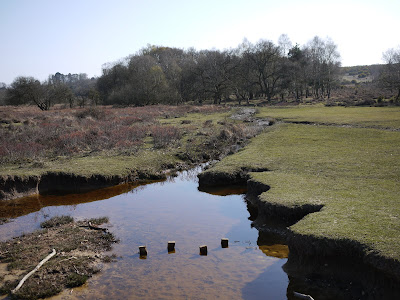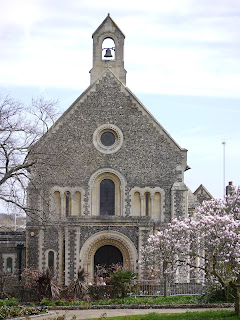Another in our sequence of walks with our friends from Chichester. This one starts at Wanborough station. You walk south and quickly join a field path heading towards Wanborough village with the low ridge of the Hog's Back on the horizon.

The village of Wanborough boasts a (rather ugly) 17th century manor house, the tiny 13th and the famous Great Barn. You head further along the road south and fork right through a field of oilseed rape, where the public footpath has been shamefully planted over, to reach the Hogs Back and the busy A31. Although it looked low when first sighted, the views from here back towards Wanborough and beyond are impressive.

After taking our lives in our hands to cross the A31, we were pleased to find that the view on the other side looking down to Puttenham was equally rewarding. You can see St John the Baptist church in the foreground and Puttenham Priory behind. Pevsner describes this as a “a handsome pattern-book builder’s house of 1762” and as a good example of a provincial Palladian house.

As we walked down the track towards Puttenham, we glanced into a sloping field on the right and were startled to see a number of isolated men sunbathing, seemingly naked. At first we could not imagine what was going on, but gradually it dawned on us.
Through the very pretty village of Puttenham and onto the North Downs Way past the golf course. Then a crossing of the busy A3 by an overpass and on to Compton. As we approached we were thrilled to see the first proper bluebell wood of the year - presumably accounted for by the sunny slope on which they were situated.

We had lunch at the excellent Harrow Inn and then looked at St Nicholas church which is a delight. The tower and chancel are 11th century, but pre-Norman; the nave, aisles and the unusual two-storey sanctuary (which can be glimpsed through the chancel arch) come from later in the 11th century and the middle of the 12th.

A bit further along the way we came to the Watts Memorial Chapel, which I had hoped would be the highpoint of the walk - and I was not disappointed. The chapel was built in 1896 as a memorial to the painter GF Watts by his wife, Mary.
From the outside it is a riot of red brick and terracotta panels with Celtic designs, and perhaps seems out of proportion. The low angle of this photo exaggerates its height.

Inside it is even more extravagant, and the magnificent art nouveau decoration puts you in mind of Vienna and paintings by Klimt or Beardsley. I wondered how a building of 1896 could have such decoration, but it turns out that the inside was designed in 1901.

We would also have visited the nearby Watts Gallery but it is currently closed for restoration.
From here we rejoined the North Downs Way heading back towards Puttenham. Part way along, by the splendid red brick Monks Grove Farm, we turned right, soon crossing fields and then the A31 again - more difficult as the afternoon rush hour was now underway. We headed back down to Wanborough and retraced our steps to the station.
From: The Times 3 April 2010 Well done Christopher Somerville, but would-be walkers should know that the sketch map provided needs to be supported by an OS map and is remarkably coy about the two main roads which have to be crossed.
Map: Explorer 145 (Guildford and Farnham).
Conditions: dry, sunny, very warm.
Distance: supposedly 7 miles, but we estimated it as over 8.
Rating: four stars. Wonderfully varied and full of interesting things to see, both natural and man-made.
Sightings
Not many butterflies around but quite a good selection: Brimstone, Small White, Large White, Orange Tip, Peacock, Small Tortoiseshell, Red Admiral, Speckled Wood.
Flower of the day
Much to my frustration I have not been able to identify this plant. We saw a large quantity of it right by the path as we stopped to admire the bluebells.














































